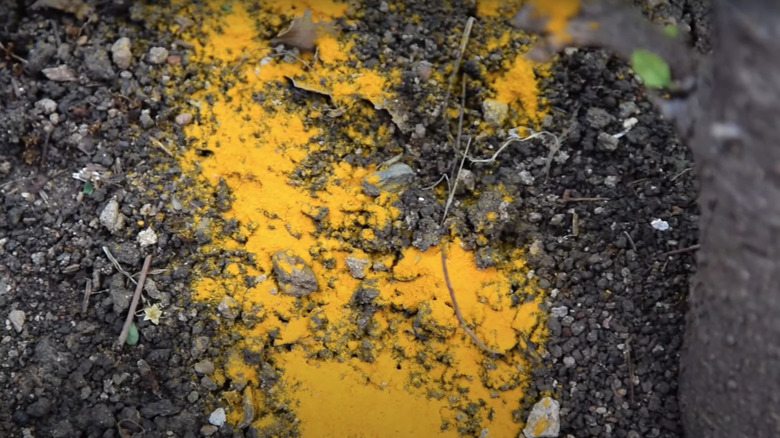Here's How Turmeric Works As A Pesticide When Added To Your Garden
Discovering harmful insects in your garden is one of the most challenging and disheartening experiences. While the bugs themselves may be small, they can wreak havoc on crops seemingly overnight, reducing your harvest and potentially killing your plants. But you don't have to turn to commercial pesticides to drive those tiny tyrants out of your garden. Instead, search your spice rack for a jar of turmeric. This versatile ground spice is easy to find and purchase at grocery stores around the world. Besides being a tasty and healthy ingredient in curries, soups, stews, and rice dishes, turmeric can also be used as a powerful organic pest control. Turmeric repels many harmful insects with its strong scent and taste and can even drive away buried pests with the threat of suffocation.
Unlike chemical pest control methods, turmeric is completely safe to eat and won't harm you if you happen to ingest it from fresh garden produce. Learn more about how turmeric repels insects, the type of pests it controls best, and the many versatile ways to use this ingredient in your garden.
How to use turmeric in your garden
Turmeric is a spice with many benefits, as there's more than one way to use it in your garden! To tackle visible pests like aphids and mealybugs, mix 1 part turmeric into 10 parts water and shake it up in a spray bottle. Mist the turmeric water over all your garden plants, focusing on the undersides of leaves and stalks where pests like to hide. Alternatively, you can sprinkle turmeric directly on your garden soil and around ant piles to drive them away from your backyard. If underground grubs or fungus gnats are your biggest issue, Mix 1 tablespoon of turmeric powder into one gallon of soil before adding it to your garden or repotting plants. Stay consistent with applications for the best results, but be careful not to oversaturate with turmeric, as the spice is somewhat acidic and can damage roots in high concentrations.
Purchasing all that turmeric at the store can add up, but you can also plant turmeric in your garden to discourage pests as it grows and harvest for later use. Turmeric is relatively easy to grow in warm and humid environments and will thrive in hardiness zones 8 and higher. In addition to helping with garden pests, turmeric can also treat powdery mildew and other fungal infections, heal damaged plants, and repel mosquitoes when sprayed on yourself!
Other ways to use turmeric
Turmeric powder mostly works because insects dislike the strong, bitter odor and taste. When applied to leaves and stems, bugs will be hesitant to take a bite, but the miracle herb also protects against underground pests when sprinkled or mixed into the soil. Ar-turmerone, one of the main compounds in turmeric oil, has been found to be just as effective as synthetic DEET at repelling mosquitoes and other pesky insects, according to a study published in Scientific Reports. Turmeric powder is even powerful enough to get rid of bed bugs; because of its antimicrobial properties, turmeric depletes oxygen in mattresses and soil, forcing bugs to leave the area or suffocate, in addition to making their food source taste bad.
Turmeric, as a natural pest control, works best against ants, aphids, grubs, caterpillars, and mealybugs. Unfortunately, turmeric won't do much to repel squirrels, rabbits, and rats from your garden. However, similar flavorful spices and herbs can! For protection against both insects and rodents, try employing a mixture of turmeric and chili, garlic, or vinegar.


